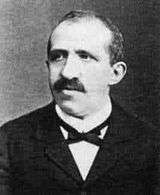Leo Königsberger
| Leo Königsberger | |
|---|---|
|
Photograph of Leo Königsberger, 1886 | |
| Born |
15 October 1837 Posen, Prussia |
| Died |
15 December 1921 (aged 84) Heidelberg, Germany |
| Nationality | German |
| Fields | Mathematics |
| Institutions |
University of Heidelberg University of Vienna |
| Alma mater | University of Berlin (Ph.D., 1860) |
| Thesis | De motu puncti versus duo fixa centra attracti (1860) |
| Doctoral advisor |
Karl Weierstrass Ernst Kummer |
| Doctoral students |
Karl Bopp Jakob Horn Edmund Husserl Gyula Kőnig Georg Alexander Pick Alfred Pringsheim Max Wolf |
Leo Königsberger (15 October 1837 – 15 December 1921) was a German mathematician, and historian of science. He is best known for his three-volume biography of Hermann von Helmholtz, which remains the standard reference on the subject.[1]
Biography
Königsberger was born in Posen, the son of a successful merchant. He studied at the University of Berlin with Karl Weierstrass, where he taught mathematics and physics (1860–64). He taught at the University of Greifswald (assistant professor, 1864–66; professor, 1866–69), the University of Heidelberg (1869–75), the Technische Universität Dresden (1875-77), and the University of Vienna (1877–84) before returning to Heidelberg in 1884, where remained until his retirement in 1914.[1]
In 1919 he published his autobiography, Mein Leben (My Life). The biography of Helmholtz was published in 1902 and 1903. He also wrote a biography of C. G. J. Jacobi.[1]
Königsberger's own research was primarily on elliptic functions and differential equations. He worked closely with Lazarus Fuchs, a childhood friend.[1]
Notes
- 1 2 3 4 Rines 1920.
References
-
 Rines, George Edwin, ed. (1920). "Koenigsberger, Leo". Encyclopedia Americana.
Rines, George Edwin, ed. (1920). "Koenigsberger, Leo". Encyclopedia Americana.
External links
- O'Connor, John J.; Robertson, Edmund F., "Leo Königsberger", MacTutor History of Mathematics archive, University of St Andrews.
- Leo Königsberger at the Mathematics Genealogy Project
- Mathematical publications from the University of Heidelberg.
- Extended autobiography (in German) from the University of Heidelberg.
- Works by Leo Koenigsberger at Project Gutenberg
- Works by or about Leo Königsberger at Internet Archive
